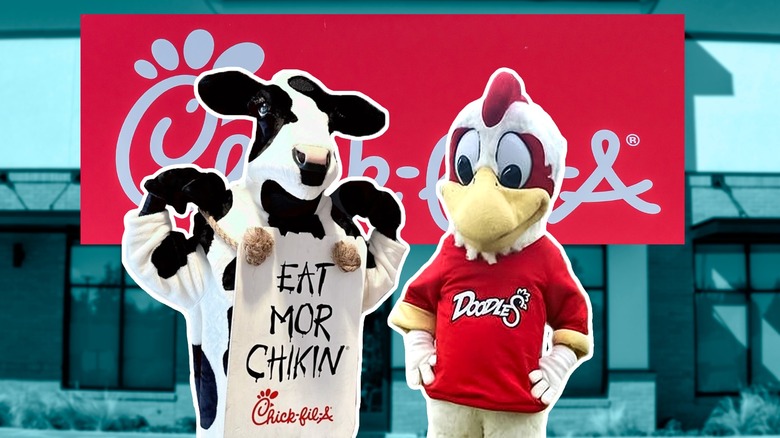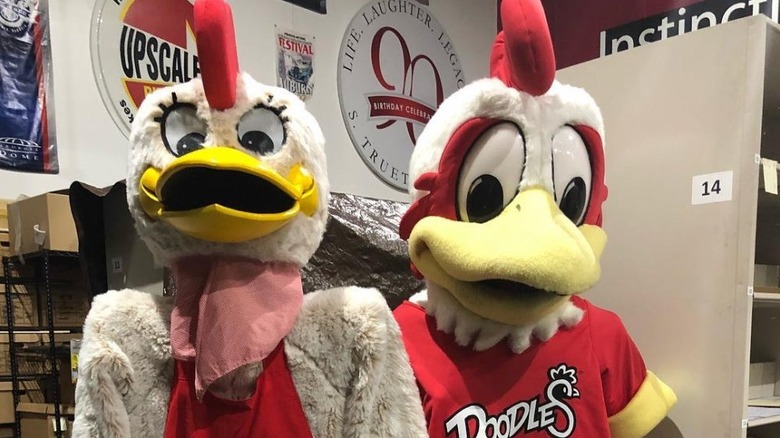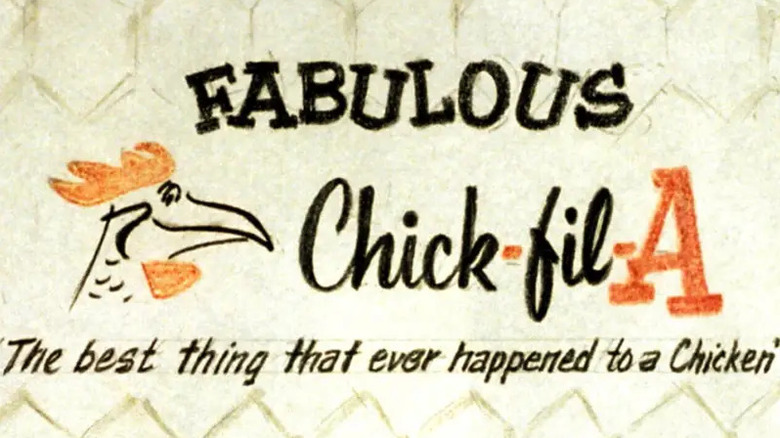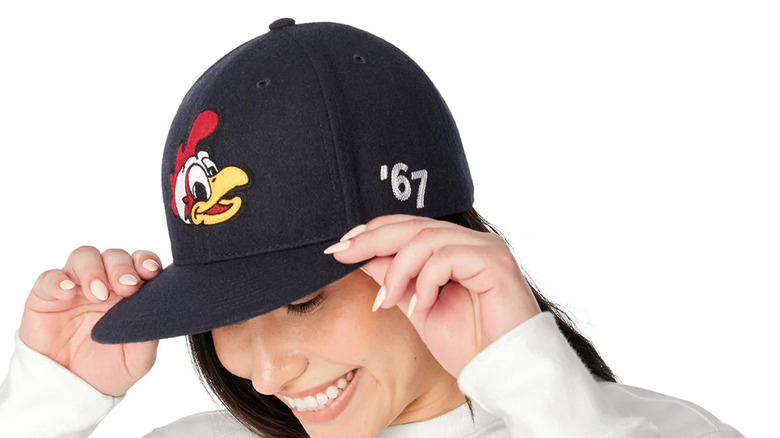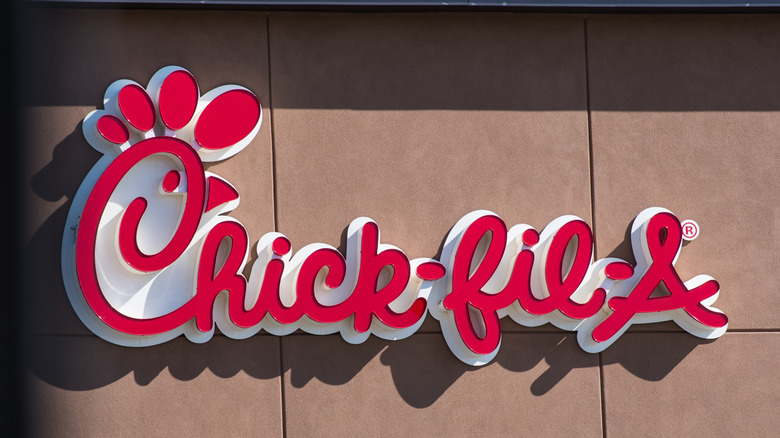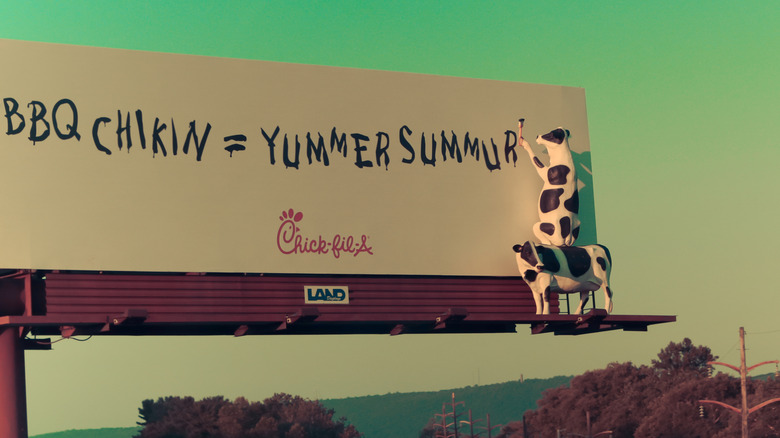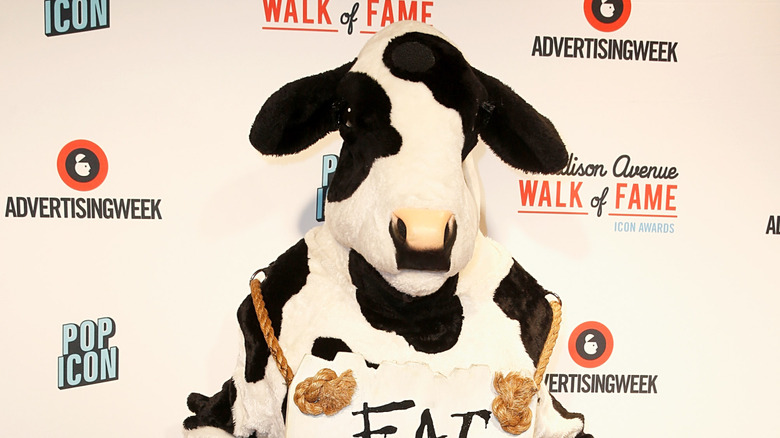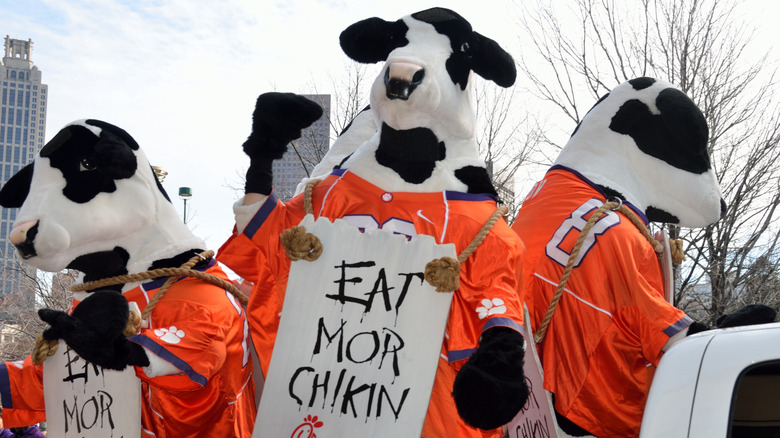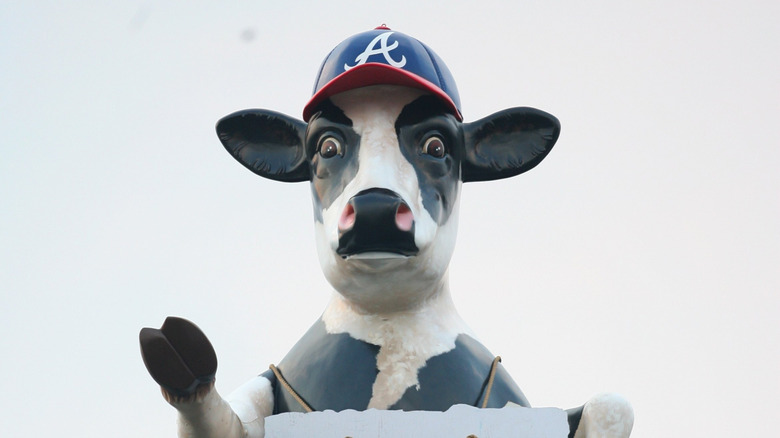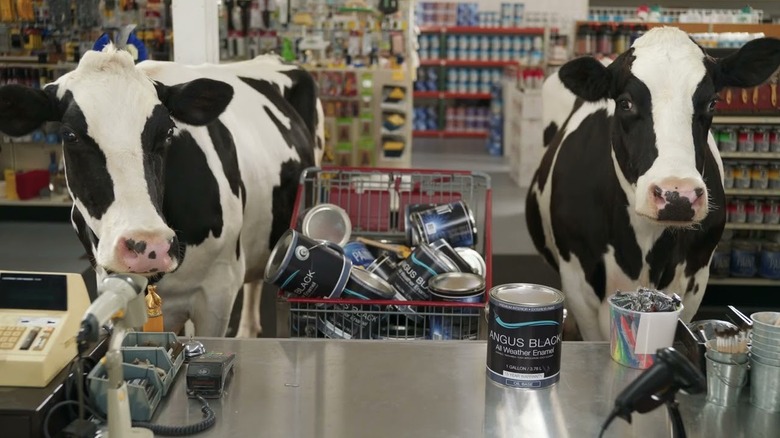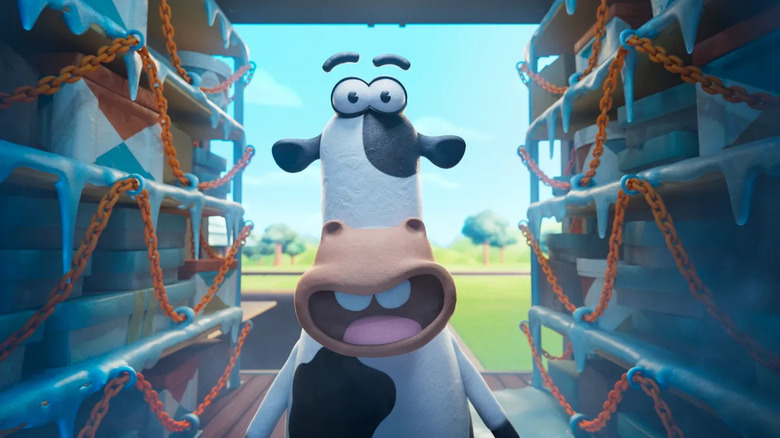10 Things You Never Knew About Chick-Fil-A's Mascots
Cruising along an American interstate you're sure to see a few billboards. After a while, all of the roadside advertisements seem to blur together. Then, along that endless stretch of highway, something catches your eye. One cow precariously stacked atop another, leaning against a sky-high billboard. The uppermost farm animal friend wields a paintbrush and in jet-black ink has scribbled a plea for you to "Eat Mor Chikin."
Of course, you decide to make a pit stop and fuel up with a tender, juicy chicken sandwich and some refreshing, freshly brewed sweet tea. And it's all thanks to those boisterous bovines. Chick-fil-A's approach to advertising sure is creative, and it has captured the attention of diners all across the nation with its rambunctious spotted mascots. But even though they've become a staple in fast food marketing, there are a few things you may not know about Chick-fil-A's iconic animal ambassadors, both past and present.
The cows weren't Chick-fil-A's original mascot
While today Chick-fil-A fans know, love, and actively look for the naughty cows stirring up trouble and scrawling on billboards, the quick-service restaurant originally had a mascot you may have never heard about. Instead of those bold bovines, when the fast food joint first started, Chick-fil-A (rather predictably, one might say) featured a chicken as its emblem. Named Doodles, the initial mascot was a big-eyed rooster with a friendly smile who sought to promote the restaurant chain's oh-so-tasty chicken sandwiches.
But apparently, an anthropomorphized cartoon bird encouraging prospective customers to take a bite out of its feathered brethren wasn't the winning marketing formula. Though Doodles was around for decades, being complicit in chicken cannibalism, it turns out, doesn't have the same widespread appeal as a few high-spirited Holsteins up to some hijinks. Doodles the rooster eventually departed for the big chicken coop in the sky, so you won't see the former mascot on advertising materials anymore.
Doodles had a different slogan than the Cows
Nowadays, the phrase "Eat Mor Chikin" is synonymous with Chick-fil-A and its crazy cattle. But during Doodles's time, the restaurant chain utilized a different slogan to entice hungry customers: "The best thing that ever happened to a Chicken." Considering that Chick-fil-A continues to report huge positive sales growth – bringing in more than $21 billion in 2023 – it's clear that the general public agrees with that sentiment.
Nonetheless, once Chick-fil-A phased Doodles out and ushered those mischievous cows in, the fast food giant opted to swap out the lengthy slogan that came along with the rooster. The current slogan is far snappier and much simpler than the former tagline, coming in at only three (poorly spelled) words opposed to the original's nine. With the cows bringing a bright, playful energy to the restaurant chain's marketing strategy, it only follows that the slogan reflects that same lighthearted vibe.
Doodles can be found on some Chick-fil-A merch
Doodles' heyday might be decades in the past, but if you're one of the folks who remembers and misses that friendly-faced rooster, you're in luck. Sift through all the fast food chain's cow-print and food-shaped clothing and accessories and you'll find two Chick-fil-A merchandise items emblazoned with the former mascot's face. You can further celebrate the chicken chain's history with a strand of string lights curiously shaped like Chick-fil-A's original chicken sandwich.
Coming in at a cool $50.00, you can sport a white Chick-fil-A Heritage Doodles Crewneck sweatshirt with an embroidered felt patch of the original mascot right on the sleeve. Or, if a cap is more your style, for only $32.00 you can don the black Chick-fil-A Heritage Doodles Wool Hat with the same patch displayed prominently on the front. Through all the cow craziness, Chick-fil-A still pays homage to good old Doodles.
Doodles is still memorialized in the Chick-fil-A logo
Beyond apparel, there's another way that the fast food chain gives a nod to its former mascot: the Chick-fil-A logo. Though Doodles is no longer the star of its marketing efforts, the chicken restaurant still acknowledges the rooster in the first "C" in Chick-fil-A's branding plastered on packaging, merchandise, and the exterior of the McDonough, Georgia location with the two-story, four-lane drive-thru.
The logo has evolved significantly, and early iterations featured a far more representational sketch of the mascot. More recent versions are more abstract, but the modern logo still pays homage to Doodles the Rooster. That first "C" in "Chick-fil-A" curls in on itself to make the rooster's head, and the image comes to life with an eye, beak, and a bright red comb. With the cows being as popular as they are, Chick-fil-A hasn't forgotten its roots. And it prioritizes its root vegetables too, with an Idaho-based company being the potato supplier behind Chick-fil-A's waffle fries.
The cows were first introduced in 1995
For many of Chick-fil-A's loyal customers, it's hard to imagine a time before the famous cows. But those hilarious Holsteins didn't actually debut until 1995. The cows were first introduced to the world on a billboard in Atlanta, Georgia scribbling the now iconic slogan "Eat Mor Chikin." That plea to cut back on beef is a tad bit ironic, though, considering the fact that Chick-fil-A has two restaurants that feature burgers on their menu.
For decades, the cows have been spotted on roadside advertisements across the United States, and it was thanks to the genius minds at The Richards Group, an award-winning branding and advertising agency based in Dallas, Texas. Chick-fil-A worked with the agency for more than 22 years before the fast food giant called it quits in 2016 to focus on other (read: non-cow) aspects of its marketing efforts. But even if their shenanigans aren't being spotlighted like they once were, the cows still hold a special place in many customers' hearts.
Chick-fil-A's mascots are in the Madison Avenue Advertising Walk of Fame
Stroll down Hollywood Boulevard and you'll see stars like Dwayne "The Rock" Johnson and Dolly Parton along Tinseltown's Walk of Fame. But head to the Big Apple and you'll find different kinds of icons at the Madison Avenue Advertising Walk of Fame. Since 2004, Advertising Week in New York City has highlighted beloved brand ambassadors, and in 2007 the Chick-fil-A cows were bestowed with that honor.
That year they shared the spotlight with the late, great popcorn spokesman Orville Redenbacher. Redenbacher passed on in 1995 when the cows were introduced. By the time they were inducted into the walk of fame, the Chick-fil-A mascots had spent more than a decade devoted to their mission of coaxing fast-food diners away from beef. It was all thanks to The Richards Group's inventive and creative approach to get consumers to ditch burger joints and turn toward Chick-fil-A's own fried chicken sandwiches instead.
The cows' slogan was the center of a lawsuit Chick-fil-A filed against Burger King
The barely literate cows luring customers toward chicken was certainly an eye-catching move, so it's no wonder another fast food joint attempted to co-opt the advertising strategy. In the of summer 2000, Burger King, known for its flame-broiled beef, tried to use some feathery friends to convince diners to grab a Whopper.
Coinciding with the release of the hit animated movie "Chicken Run," Burger King asked customers to chow down on beef and save the chickens. Following a cease and desist letter that went without a response, Chick-fil-A promptly filed a lawsuit, claiming the burger chain's advertising efforts encroached on the chicken joint's own copyrights and trademarks of its then five-year-old "Eat Mor Chikin" advertising device. Soon after, the case appeared before a federal judge, who ultimately accepted an agreement between the two fast food giants. Burger King quickly concluded the campaign.
About a decade later, Chick-fil-A engaged in another legal battle, this time against a Vermont man who prints t-shirts and other apparel with the slogan "Eat More Kale." Though the restaurant chain was able to take down Burger King to defend its cows, Chick-fil-A lost to Bo Muller-Moore, who ultimately trademarked his veggie-forward slogan and still sells the shirts today.
Billboards aren't the cows' only form of advertising
Though the billboards might be their most iconic form of advertising, the Chick-fil-A cows have done more. Whether it be the "Eat Mor Chikin" campaign's radio advertisements or the real-life cattle in the television commercials, those kooky cows have left their mark on the media landscape. They've even taken to social media, posting about their shenanigans on the Eat Mor Chikin Cowz Facebook page.
The cows might have larger-than-life personalities, but there's one particular cow that actually is larger than life. Weighing in at 36,000 pounds and standing tall at 40 feet, one of Chick-fil-A's iconic mascots looks down over Truist Park, the home of the Atlanta Braves. If that's too much cow for you, fret not. You can always take home a Chick-fil-A Plush Standing Cow for $35.00 from the restaurant chain's online merchandise store, or browse the rest of its Cow Collection for apparel, games, and even drinkware.
The real-life cows in the commercials have names
Remember those chuckle-worthy Chick-fil-A television commercials with the cows buying more paint or staging a thunderstorm to prevent humans from hosting a burger cookout? Yep, those were real cows. And they've got names, too.
The fast food restaurant revealed the identities of the friendly farm animals in a 2015 YouTube video in honor of the 20th anniversary of the cows' "colorful antics." Cared for buy a man known as Cowboy Phil, the bovines are named Freedom, Freckles, Molly, and Cat. The cows needed to learn a variety of tricks for the commercials and Phil taught them everything.
Though the cows are on a mission to get humans to cut back on beef and nosh on some juicy chicken, the breed of cows used in Chick-fil-A's marketing aren't beef cows. But in the video, Phil explains that their easy-to-spot black and white print prompted the restaurant chain to adopt the pattern as part of its brand identity.
The cows starred in two Chick-fil-A short films
TV commercials only provided Chick-fil-A's mascots with bite-sized storylines, so in 2023 the fast food chain released two original short films to give their customers a bigger taste of all the chaos their cows can cook up. In "Tha Billbord," animated versions of the cows — these ones named Carrots, Daisy, and Sarge — spot an advertisement from their fictional fast-food nemesis Circus Burger. Daisy calls a "Code Moo" and her bovine buddies band together to destroy the beefy billboard. "Rocky Road" is an equally lighthearted and fun featurette with silly Carrots getting trapped in a Circus Burger delivery truck, thus requiring an elaborate rescue from Daisy and Sarge.
Though those two short films highlighted the ever-iconic cattle, Chick-fil-A has also capitalized on its non-cow advertising with other animated, people-focused shorts with heartwarming messages at the center of the stories. Since 2019, "The Stories of Evergreen Hills" (and now "Legends of Evergreen Hills") series have become much anticipated Chick-fil-A holiday traditions, but the cow shorts are still fun.
